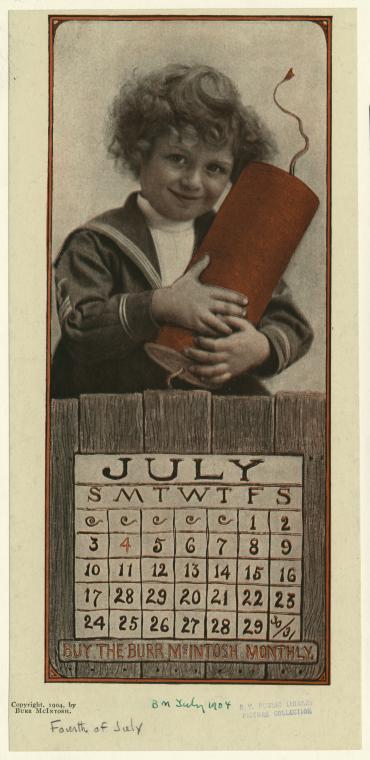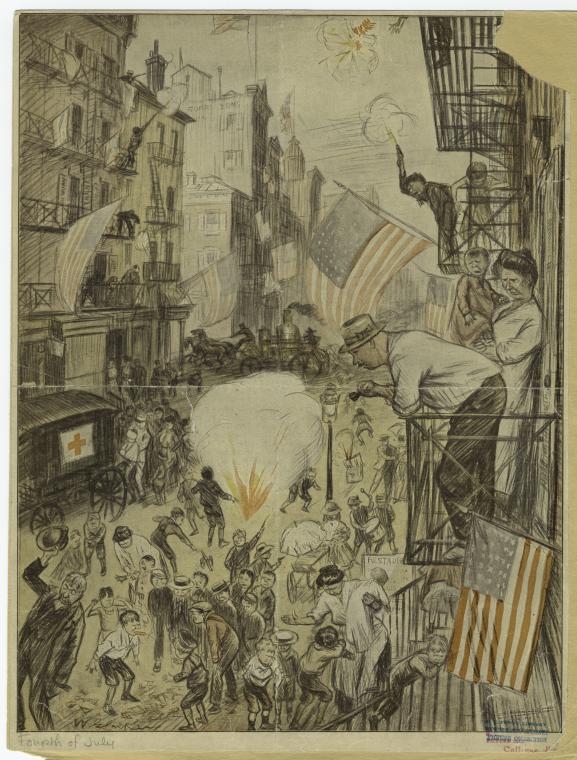Independence Day Booths: Fourth of July Feasting in 19th Century New York

Ready for Fourth of July barbeques? Of course you’ll be having some pickled oysters, egg nog, and lobster, right?

If you think these are some interesting cuisine choices for Independence Day festivities, 19th century New Yorkers would disagree.
Each year, among the swarms of people and blazing fireworks that filled New York City streets, the notorious Fourth of July booths arose. A tradition associated with clashing symbols of patriotism and immorality, one element remained unquestionable about these booths: They dished out an interesting menu.
Patriotism and Pyrotechnic Mania
The United States’ independence “ought to be solemnized with pomp and parade, with shews, games, sports, guns, bells, bonfires, and illuminations from one end of the continent to the other.” –John Adams, in a letter to his wife Abigail, 1776 (McNamara).
Former Independence Day celebrations consumed New York City in every capacity. The city's festivities sparked excitement among adventurous instigators and thrill-seeking spectators, while causing “the bitter annoyance of all persons of quiet habits and sensitive nerves” (Hone).
Thousands of military and civilians marched in parades, elaborate banquets were thrown, patriotic plays were performed, and religious services featured orations of the Declaration of Independence and Washington’s Farewell Address.
Surrounding these formal events, however, was the chaos and destruction of bonfires, fire-crackers, guns, pistols, rockets, Roman candles, fire-balloons, and “every other possible contrivance for making a blaze and a noise” (Harper’s Weekly, July 8, 1871).

Considered a 'boys' holiday,' fireworks filled street corners, alleyways, and every space possible. Hordes of celebrators were left to trudge through gunpowder and smoking debris, and dodge the effects of homemade torpedoes and cannons.
"Rockets are fired in the streets, some running horizontally up the pavement, and sticking into the back of a passenger" (The Irish Penny Journal, August 22, 1840).
Though illuminated shores and continual blasts "would have led one to fancy that the city was undergoing a vigorous siege," reckless participants were not in the least deterred by potential danger. Fun and peril were synonymous among these die-hard celebrators, and “it seemed as the whole population of New York had been seized with a pyrotechnic mania." Despite these dicey conditions, however, “the streets in the lower part of the city filled [each year] with red-faced, weary-limbed, overheated men, women, and children" (Hone).

Booths of Contention
In the midst of this confusion stood the ever-controversial Independence Day booths. Stretching three miles on both sides of Broadway and surrounding City Hall Park, the notorious booths emerged annually as a time-honored patriotic tradition.
From the late 18th century through the mid-1840s, these food and drink stands were constructed every Fourth of July eve, ready to indulge the herds of celebratory crowds the following day. Among the "light and luscious" fare served up by the booths were oysters, boiled hams, lobster, clams, pineapples, puddings, pies and other treats - with a roasted pig as the centerpiece of each one (National Advocate, July 8, 1824).

"For a small amount of money a big piece of roast pig could be had, and clams were gratuitous—thrown in, so to speak" (Harper's Weekly, July 7, 1894).
Where "everything drinkable [was] to be had but water," mobs also enjoyed an abundance of mead, beer, cider, eggnog, and “other beverages, more exhilarating, perhaps, but less innocent" (Hone; Still). Though signifying absolute patriotism to some, such indulgences were quite unpopular with temperance advocates and conservatives.

An Anti-Booth Movement
Branded as an immoral, unnecessary, and a "highly improper" social evil, the Fourth of July booths were accused of corrupting the nation's holiday with "disgusting scenes of vulgarity, profanity, rioting, and drunkenness" (Commercial Advertiser, June 11, 1827).
"Our wives and children, who might else ramble through [the booths], in the enjoyment of innocent mirth and healthful pastime, are shut out by whiskey kegs and cider barrels, rum sellers and rum drinkers, until the grass plats which adorn the Park are strewed with drunken men and women, and its paths thronged with reeling sots. And all of this on the Fourth of July—our national jubilee!" (Commercial Advertiser, June 27, 1840).
Aside from a moral standpoint, the compactly-arranged booths were not entirely practical. The "four or five hundred tents and booths set up in and around the Park and Battery" presented a serious space issue. As the cause for chaos and inaccessibility of public grounds, many argued that these booths had to go (Evening Post, June 11, 1840).
Though booth-abolishing petitions were signed by thousands, supporters maintained the booths' value as “an easy way to satisfy the immense number of persons, citizens and others, who celebrate the great and only national festival" (Hone). Others clung to the booths as a memory of the "patriotism of our childhood," and were reluctant to see the custom disappear (The Subterranean, June 20, 1846).
Despite the pro-booth advocacy, the infamous stands were banned after years of protest, forever fading as a New York Fourth of July tradition.

"The Fourth of July passed away when the booths around City Hall Park were taken away" (Jenkins).
While many early New York Fourth of July traditions have now vanished, fireworks remain as a dominating celebratory force; they are thankfully, however, not usually set off by children.

Further Reading
Explore the following resources for more information on early Fourth of July celebrations:
- Fourth of July celebrations -- New York (State) -- New York
- Fourth of July celebrations
- Holidays -- New York (State) -- New York -- History
- Fourth of July orations
Search historical newspapers through America's Historical Newspapers, Proquest Historical Newspapers, and HarpWeek. Also find articles through American Periodicals and JSTOR.
Read E-Books with SimplyE
 With your library card, it's easier than ever to choose from more than 300,000 e-books on SimplyE, The New York Public Library's free e-reader app. Gain access to digital resources for all ages, including e-books, audiobooks, databases, and more.
With your library card, it's easier than ever to choose from more than 300,000 e-books on SimplyE, The New York Public Library's free e-reader app. Gain access to digital resources for all ages, including e-books, audiobooks, databases, and more.
If you don’t have an NYPL library card, New York State residents can apply for a digital card online or through SimplyE (available on the App Store or Google Play).
Need more help? Read our guide to using SimplyE.


